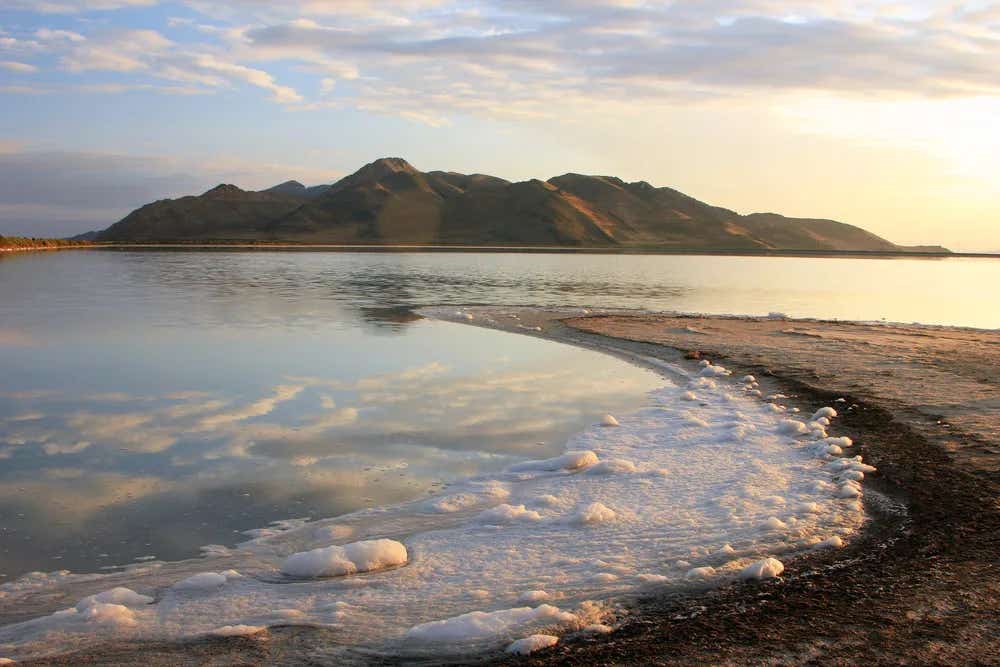Dry lake beds are a major source of greenhouse gas emissions, study finds
New research reveals that the drying lake bed of Great Salt Lake in Utah emitted 4.1 million tons of carbon dioxide and other greenhouse gases.

Great Salt Lake in Utah. (CREDIT:
Britannica)
Newly announced research by the Royal Ontario Museum (ROM) reveals that the drying lake bed of Great Salt Lake in Utah emitted 4.1 million tons of carbon dioxide and other greenhouse gases in 2020. This suggests that drying lake beds are an overlooked but potentially significant source of greenhouse gases, likely to increase due to climate change.
The findings were published in the paper “A desiccating saline lake bed is a significant source of anthropogenic greenhouse gas emissions” in the journal One Earth.
Soren Brothers, who led the research and is ROM’s Allan and Helaine Shiff Curator of Climate Change, stated, “Human-caused desiccation of Great Salt Lake is exposing huge areas of lake bed and releasing massive quantities of greenhouse gases into the atmosphere.” He emphasized the need to address the significance of lake desiccation in climate change mitigation and watershed planning.
Great Salt Lake's water level fluctuates annually, largely influenced by the amount of meltwater from surrounding mountains, with record highs in the 1980s and a record low in 2022. However, human activities such as agriculture, industry, and municipal use have increasingly consumed freshwater, depleting the lake over the years.
Similar patterns are observed worldwide, with competing uses for water significantly impacting lake levels. Iconic saline lakes like the Aral Sea, Lake Urmia, the Caspian Sea, and Great Salt Lake are drying up, destroying critical habitats for biodiversity, deteriorating air quality, and accelerating climate change as newly exposed sediments emit carbon dioxide and methane.
The research team measured carbon dioxide and methane emissions from the exposed sediments of Great Salt Lake from April to November 2020 and compared them with aquatic emissions estimates to determine the anthropogenic greenhouse gas emissions associated with desiccation. Their calculations indicate the lake bed emitted 4.1 million tons of greenhouse gases, primarily (94%) as carbon dioxide, constituting an approximately 7% increase to Utah’s human-caused greenhouse gas emissions.
Related Stories
Fieldwork was conducted while Soren Brothers was an Assistant Professor of Limnology at Utah State University, and lead author, Melissa Cobo, was a master’s student at USU. Co-author Tobias Goldhammer is a collaborating researcher at the Leibniz Institute for Freshwater Research in Berlin, Germany.
Every two weeks, they measured carbon dioxide and methane gases from the dried-up lake bed using a portable greenhouse gas analyzer attached to a closed chamber. Seven sites at one location at the south end of the lake were visited repeatedly over the year, and another three locations were sampled during an intensive three-day campaign to determine spatial variability across the lake, which spans 1,700 square miles (4,400 square kilometers) and is the largest saline lake in the western hemisphere.
Given that methane is 28 times more potent a greenhouse gas than carbon dioxide, the global warming impact of these emissions was calculated as “carbon dioxide equivalents” to account for methane’s greater impact. The data indicated that greenhouse gas emissions from the dried lake bed were strongly and positively related to warm temperatures, even at sites exposed for over two decades.
To determine whether the lake historically would have been a significant source of greenhouse gases, the team carried out measurements of near-shore emissions and analyzed water chemistry collected by the team and government data sets. These analyses showed that the original lake was not likely a significant source of greenhouse gases, making the dried-up lake bed a novel driver of atmospheric warming.
As climate change exacerbates drought in arid regions, desiccation of rivers and lakes may be contributing to climate change feedback loops. These factors should be considered in assessments of global greenhouse gas output as well as reduction policies and efforts.
Note: Materials provided above by The Brighter Side of News. Content may be edited for style and length.
Like these kind of feel good stories? Get The Brighter Side of News' newsletter.
Joshua Shavit
Science & Technology Writer | AI and Robotics Reporter
Joshua Shavit is a Los Angeles-based science and technology writer with a passion for exploring the breakthroughs shaping the future. As a contributor to The Brighter Side of News, he focuses on positive and transformative advancements in AI, technology, physics, engineering, robotics and space science. Joshua is currently working towards a Bachelor of Science in Business Administration at the University of California, Berkeley. He combines his academic background with a talent for storytelling, making complex scientific discoveries engaging and accessible. His work highlights the innovators behind the ideas, bringing readers closer to the people driving progress.



